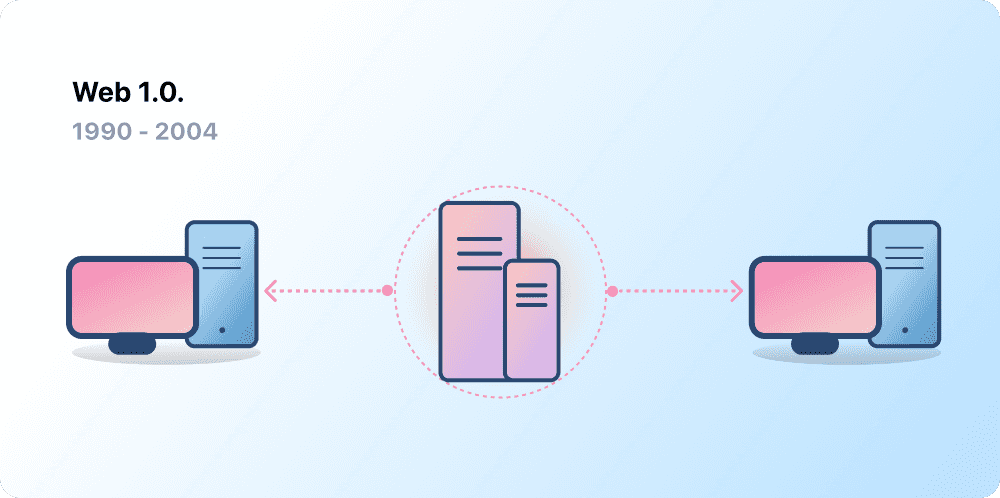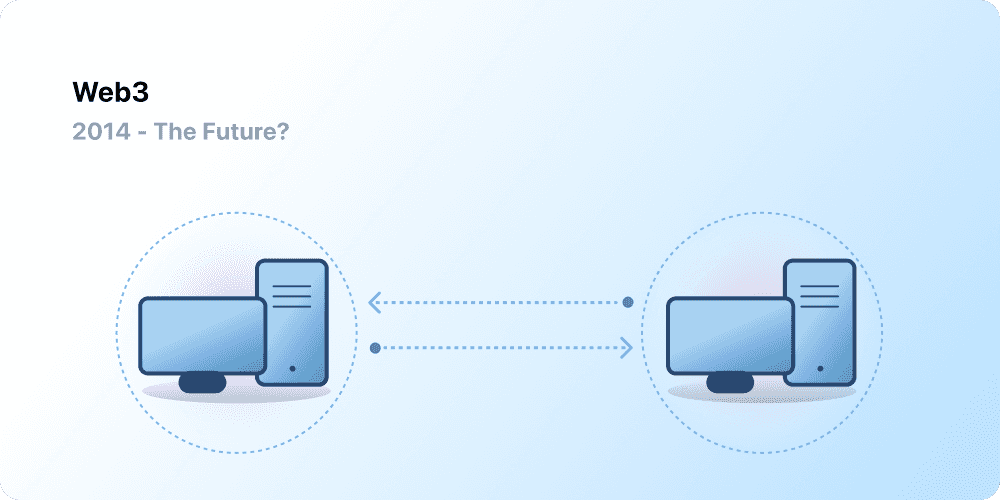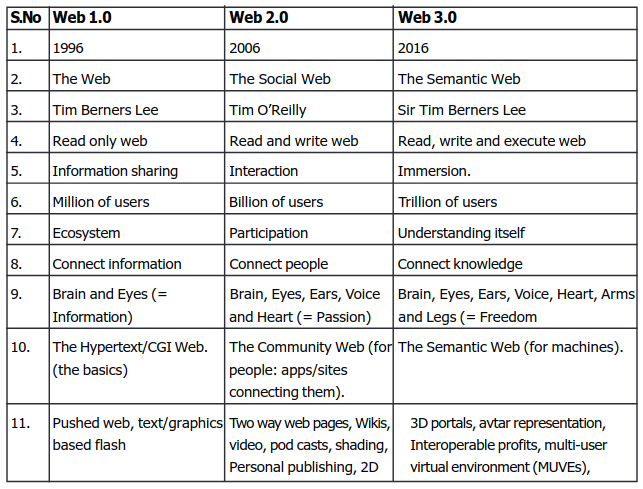A web service is a software system designed to support computer-to-computer interaction over the Internet. Web services are not new and typically take the form of an application programming interface (API). Web 3 refers to the evolution of the Internet as we know it.
The web is a system of interconnected hypertext documents accessed over the Internet. With a web browser, a user views web pages that may contain text, images, videos, other multimedia and navigates between them using hyperlinks. The web is an increasingly important resource in many aspects of life: education, employment, government, commerce, healthcare, recreation and more.
Web 1.0 was the era when people could think of Netscape as the contender for the computer industry crown. Web 2.0 is the era when people have realized that it is not the software that enables the web that matters as much as the services that are delivered over the web. New technologies will make online search smarter and may even lead to a web 3.0. Enter Web 2.0, a vision of the web in which information is divided into units of “microcontent” that can be distributed across dozens of domains.
The web of documents has been transformed into a web of data.
Web 1.0
In Web 1.0, a small number of writers created web pages for a large number of readers. As a result, people could obtain information by going directly to the source. The WWW or Web 1.0 is a system of interconnected hypertext documents accessed through the Internet. WWW or Web 1.0
The earliest implementation of the web represents Web 1.0, which, according to Berners-Lee, could be considered the “read-only web.” In other words, the early web allowed us to search for information and read it. There was very little in the way of user interaction or content contribution. However, this is exactly what most website owners wanted: their goal for a website was to establish an online presence and make their information available to anyone at any time.

In Web 1.0, advertisements on websites while browsing the Internet were prohibited. Also, in Web 1.0, Ofoto was an online digital photography website, where users could store, share, view and print digital images. Web 1.0 was a content delivery network (CDN) that allowed information to be displayed on websites. It could be used as a personal website, where certain directories that allowed users to retrieve certain information. The Web 1.0 era existed from approximately 1991 to 2004.
The four essential elements of a Web 1.0 site design include:
- Static pages.
- Content is served from the server’s file system.
- Pages created with Server Side Include or Common Gateway Interface (CGI).
- Frames and tables are used to position and align elements on a page.
Web 2.0
We are currently seeing the infancy of Web 2.0, or the “read-write” web if we go by Berners-Lee’s method of describing it. The newly introduced ability to contribute content and interact with other web users has drastically changed the web landscape in a short time. By referring to the version numbers that commonly designate software updates, the phrase “Web 2.0” suggests an enhanced form of WWW.
Technologies such as weblogs (blogs), social bookmarking, wikis, podcasts, RSS feeds (and other forms of many-to-many publishing), social software, web APIs, and online web services such as eBay and Gmail provide improvements in readability. Stephen Fry (actor, author and broadcaster) describes Web 2.0 as “an idea in people’s heads rather than a reality”. In reality, it is an idea that emphasizes reciprocity between user and provider, in other words, genuine interactivity, if you will, people can simply upload and download.

Tim O’Reilly popularized Web 2.0 as an expression when he wrote a fairly coherent definition. Web 2.0 is definitely the next big thing on the WWW. It makes use of the latest technologies and concepts to make the user experience more interactive, useful and interconnected.
It has brought another way of interconnecting the world by gathering information and allowing it to be shared effectively.
It definitely has a bright future with so many Web 2.0 based websites emerging. It is a revolution in the computer field and will definitely achieve much greater success. According to some sources, the term Web 2.0 has been around since about October 2004. According to Wikipedia, the free web encyclopedia, it is defined as Web 2.0 is a term often applied to a perceived ongoing transition of the WWW from a collection of websites to a complete computer platform that delivers web applications to end users.
The five main characteristics of Web 2.0:
- Free classification of information, allowing users to collectively retrieve and classify information.
- Dynamic content that responds to user input.
- Information flows between the site owner and users through online evaluation and comments.
- Developed API to enable own use, such as by a software application.
- Web access generates different concerns, from the traditional Internet user base to a wider variety of users.
Web 3.0
Web 3.0 is a term that has been coined to describe the evolution of Web usage and interaction that includes the transformation of the Web into a database. Web 3.0 is an era in which we will update the back-end of the Web, after a decade of focus on the front-end (Web 2.0 has focused primarily on AJAX, tagging and other front-end user experience innovations). This, in turn, leads us to the rumblings and murmurings we’ve begun to hear about Web 3.0, which seems to assure us that the vague nomenclature of Web versions is here to stay. Expanding on Tim Berners-Lee’s explanations, Web 3.0 would be something akin to a “read-write-run” Web. Web 3.0 is defined as the creation of high quality content and services produced by gifted individuals using Web 2.0 technologies as an enabling platform.
Web 3.0 is a term used to describe various evolutions of Web usage and interaction along several paths. These include the transformation of the Web into a database, a move to make content accessible through multiple non-browser applications, leveraging artificial intelligence technologies, the Semantic Web or the 3D Web. Gartner suggests the need to differentiate incremental changes to Web 2.0 from Web 3.0, however, Tim Berners-Lee coined Giant Global Graph (GGG) as another facet of Web 3.0.

Web 3.0 is a web where the concept of website or web page disappears, where data is not owned but shared, where services show different views for the same web/same data. Those services can be applications (such as browsers, virtual worlds or anything else), devices or others, and should focus on context and personalization, and both will be achieved through vertical search. One could speculate that the alliance between Google and Sun Microsystems to create a web-based operating system for applications such as word processors and spreadsheets is an early indicator of this trend.
Key defining characteristics of Web 3.0:
– Semantic Web: The semantic web enhances the web technologies demanded to create, share and connect content through search and analysis based on the ability to understand the meaning of words.
– Artificial Intelligence: By combining this capability with natural language processing, computers can distinguish information like humans to provide faster and more relevant results.
– 3D Graphics: Three-dimensional design is being widely used in Web 3.0 websites and services. Museum guides, computer games, e-commerce, geospatial contexts, etc.
– Connectivity: Information is more connected thanks to semantic metadata. As a result, the user experience evolves to another level of connectivity that takes advantage of all available information.
– Ubiquity: Multiple applications can access content, every device is connected to the web and services can be used everywhere.
– DLT and Smart Contracts: A virtually unhackable database can be made available from which one can have value for their virtually owned content. This technology enables a trusted partnership through the integration of smart contracts, not requiring the involvement of an intermediary.
Comparison between Web 1.0, Web 2.0 and Web 3.0

Conclusion
The Web offers independence and freedom.
However, if a website is not created with web accessibility in mind, it can exclude a segment of the population that can benefit the most from the Internet. Most people do not intend to exclude people with disabilities. As organizations and designers become aware of and implement accessibility, they will ensure that a wider population can access their content.
The Semantic Web (Web 3.0) promises to “organize the world’s information” in a dramatically more logical way than Google can achieve with its current engine design. This is especially true from the standpoint of machine understanding as opposed to human understanding. The Semantic Web requires the use of a declarative ontology language such as OWL to produce domain-specific ontologies that machines can use to reason about information and draw new conclusions, not simply match keywords. The effects of Web 2.0 are far-reaching and like all paradigm shifts, it affects the people who use it socially, culturally and even politically.



Reading through this comprehensive breakdown of the evolution from Web 1.0 to Web 3.0 is truly eye-opening. It’s fascinating to see how far we’ve come and where we’re headed in terms of web technology and interaction. The concept of Web 3.0, particularly with its emphasis on semantic understanding, artificial intelligence, and ubiquitous connectivity, holds immense promise for revolutionizing how we access and interact with information online. Exciting times ahead for the digital landscape!
Really interesting article!